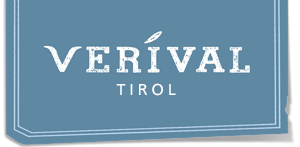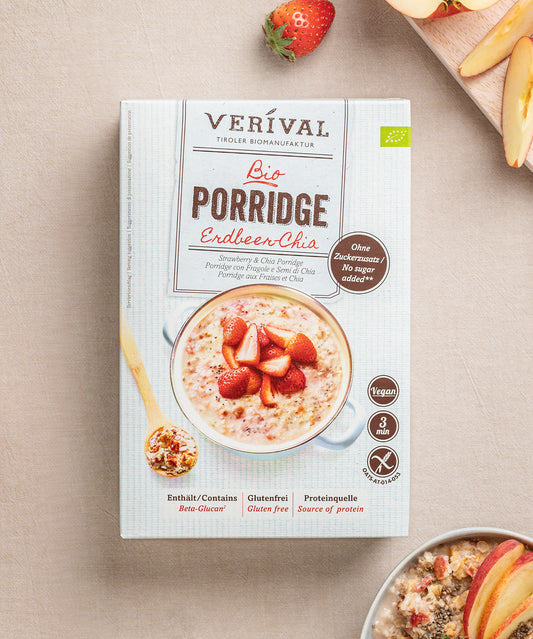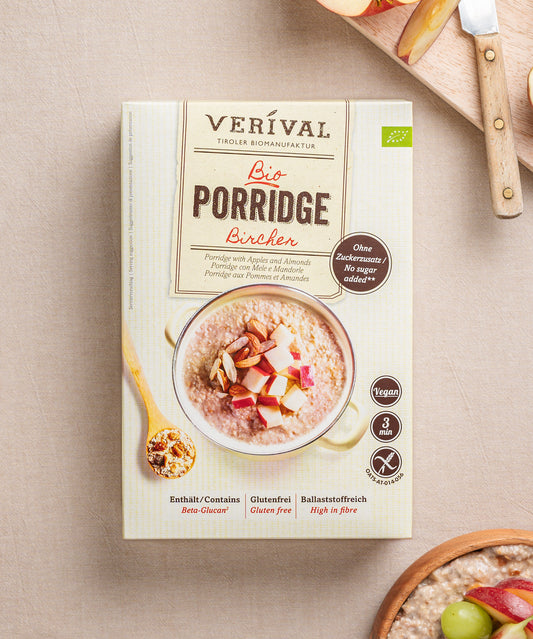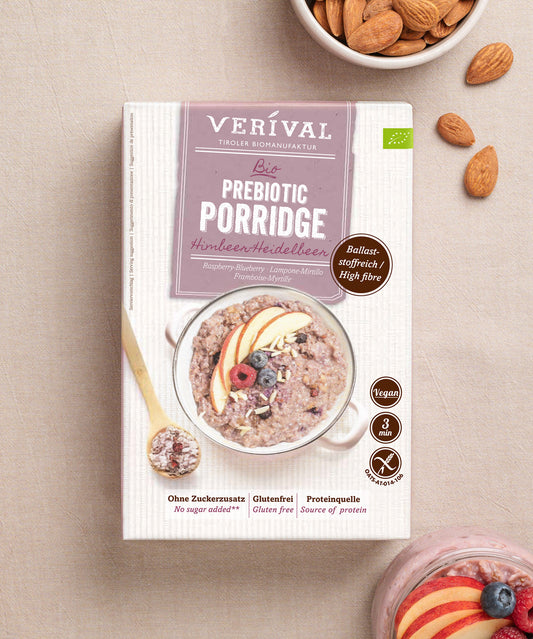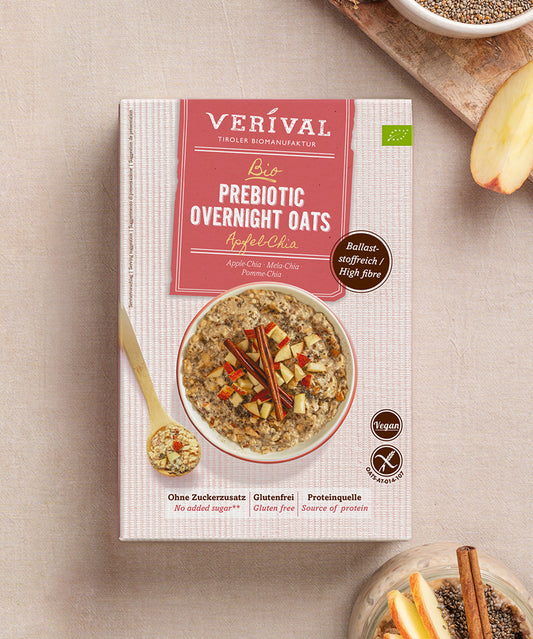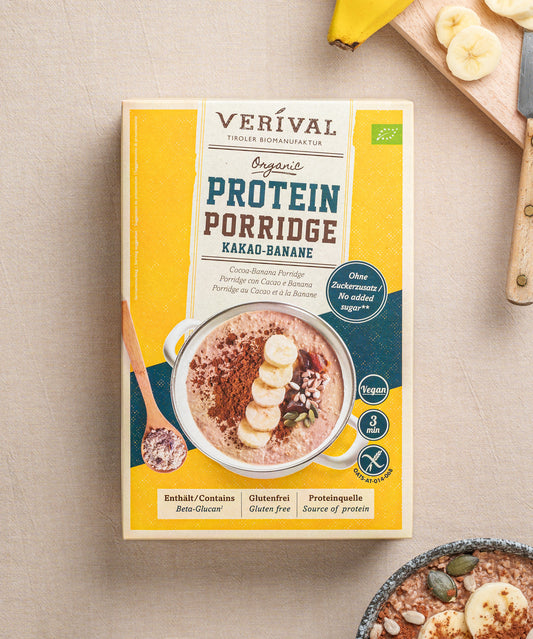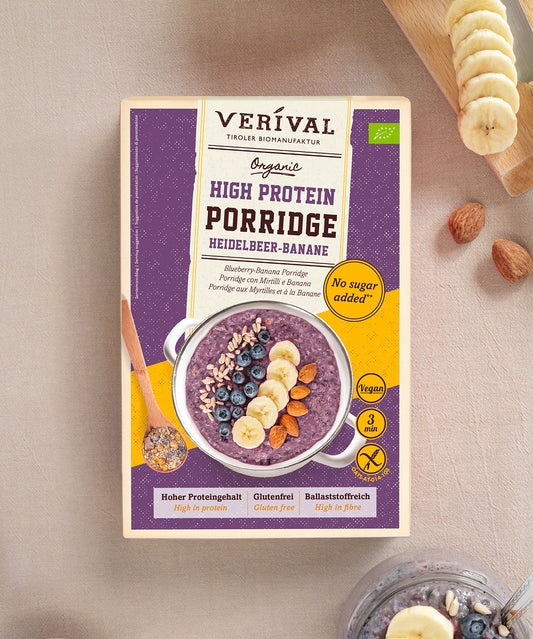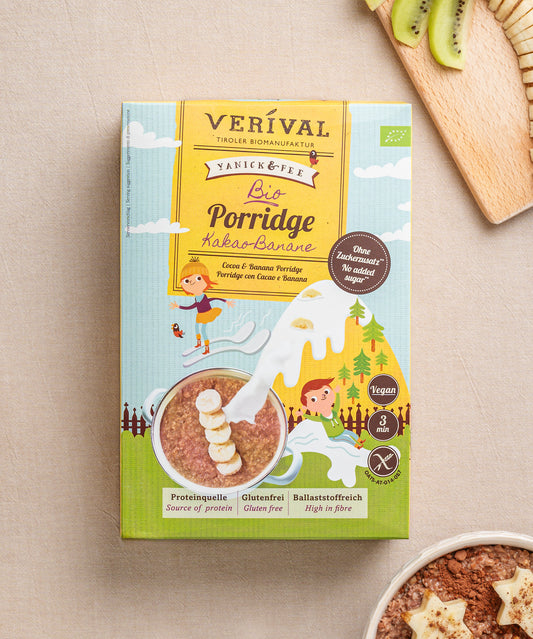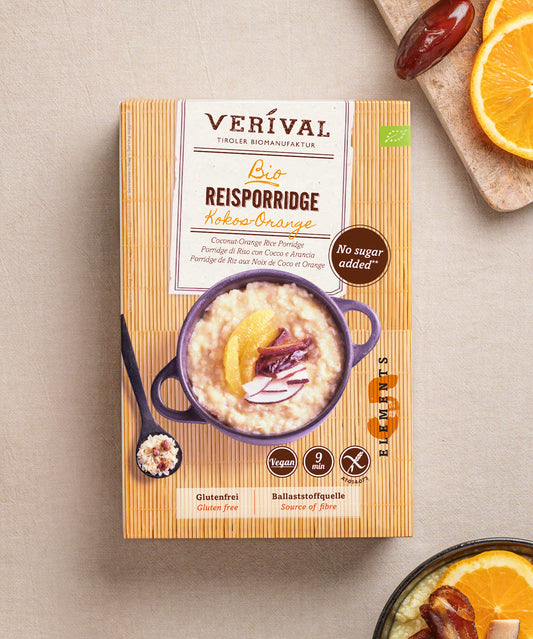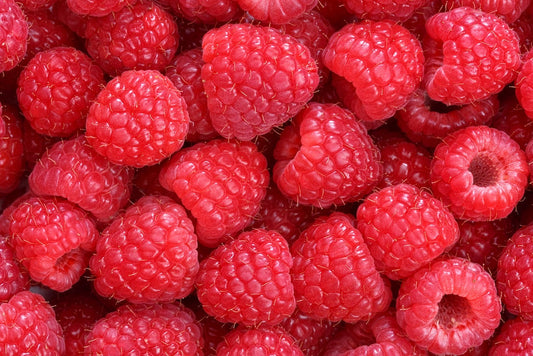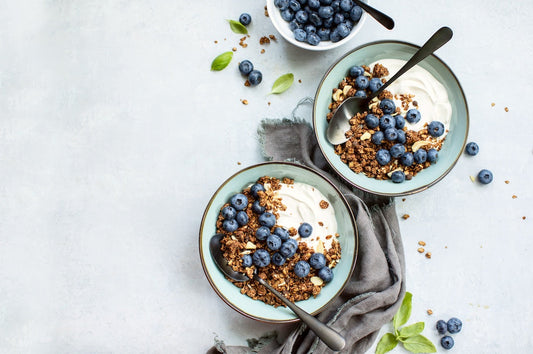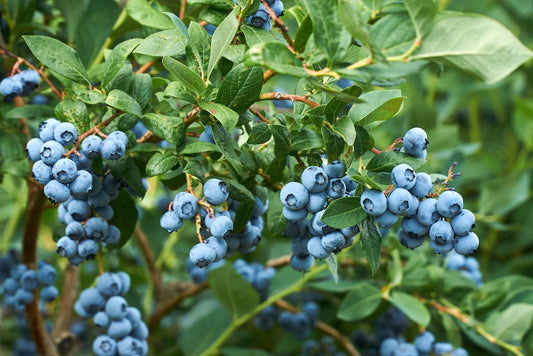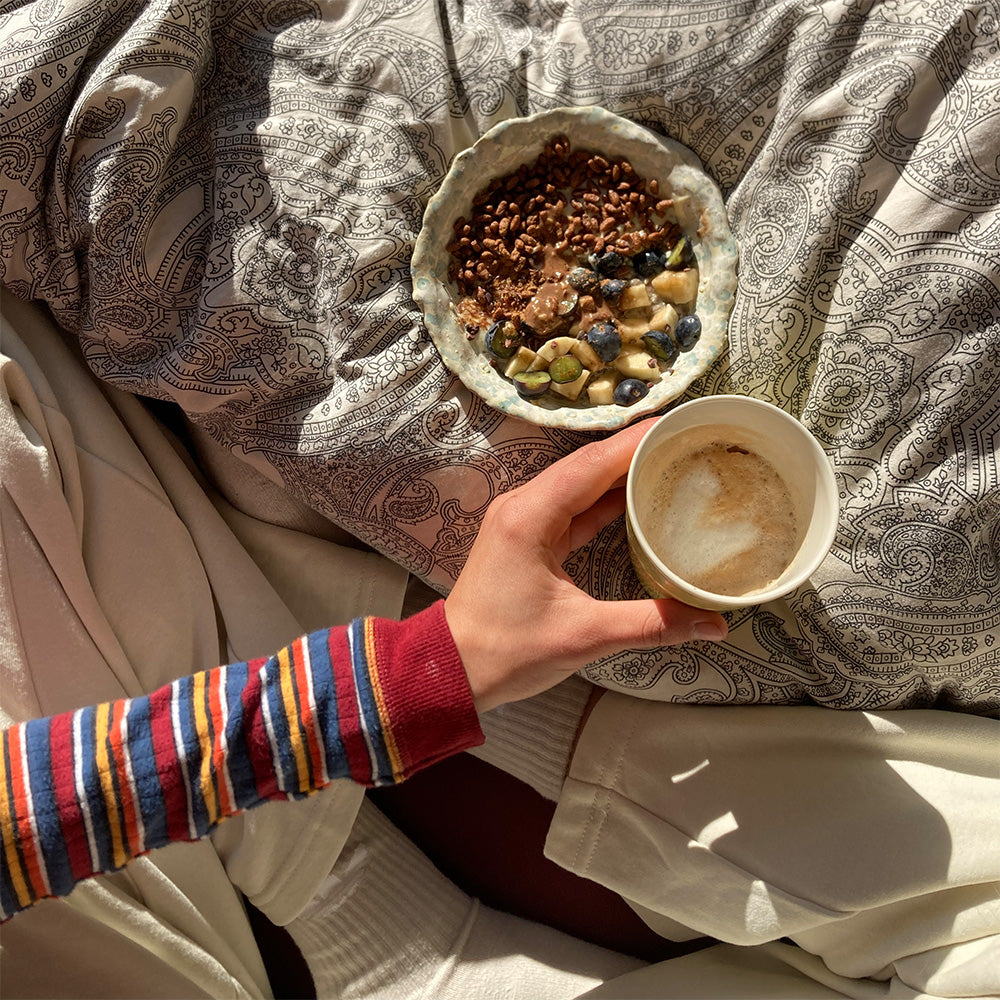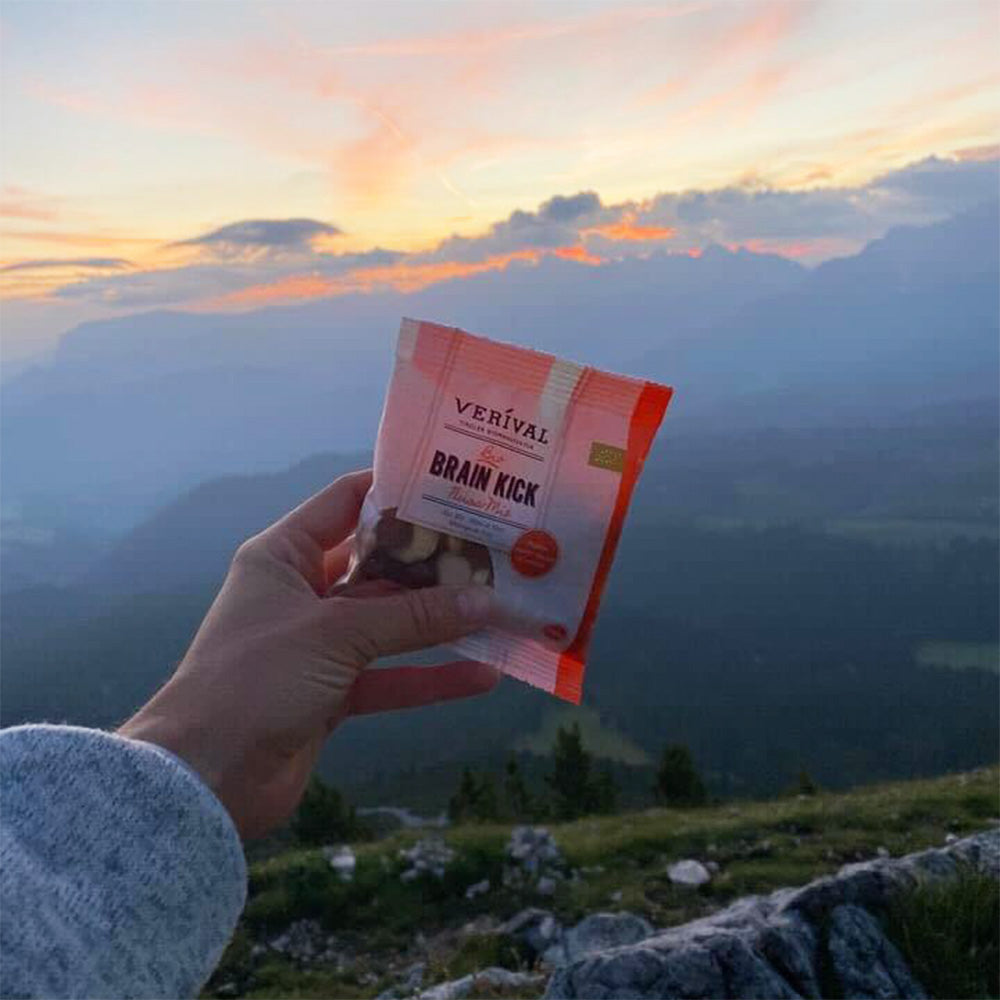Clean eating is considered a healthy way to eat, avoiding highly processed foods and instead focusing on whole foods. Clean eating, literally pure or clean eating, is said to have a positive effect on health. But how healthy is clean eating really? And how can you incorporate it into your healthy breakfast?
What is clean eating?
Clean eating is considered a healthy lifestyle diet. But what exactly makes this form of nutrition so appealing to many people?
Basically, clean eating is about consuming as much unprocessed and wholesome food as possible. Heavily processed products or artificial ingredients should be avoided as much as possible. All in all, this should lead to more well-being and energy.
Verival organic porridge full of healthy nutrients – discover it now
How healthy is clean eating?
Now, of course, you might wonder how healthy clean eating really is. Is it just one of many diets or is there perhaps more to it than that?
In fact, it seems to be the latter. As already mentioned earlier, from a health point of view, it makes perfect sense to follow the basic rules. A high nutrient density and controlled amounts of calories from foods that are minimally processed and as natural as possible can do no harm. Too much sugar or empty calories without important vitamins and minerals, on the other hand, would not necessarily be recommended.
Clean Eating – These are the advantages
From a health perspective, it makes sense to choose less processed foods over more processed products. This is because processed products usually contain a lot of calories, large amounts of unhealthy fats, and plenty of salt and sugar. All of this is intended to optimize flavor, but it also results in a nutrient composition that is questionable from a health perspective.
In contrast, ideally, low-processed foods have a high nutrient density and thus plenty of healthy micronutrients. So, here is a brief summary of the main advantages:
- Less processed foods
- Less sugar, salt and unhealthy fats
- Higher nutrient density
- Plenty of vitamins, minerals and phytochemicals
- Dietary fiber for healthy digestion
All of this together ideally means more energy for the day, no unnecessary slumps or cravings during the day and a generally higher sense of well-being.
Clean Eating – potential disadvantages
However, clean eating is not a cure-all. Avoiding processed foods does not automatically make your diet healthy. What's more, deliberately avoiding certain foods and strongly scrutinizing your own diet can lead to eating disorders.
To avoid this, you should not take a narrow view of the concept of clean eating. After all, as we know, it is the dose that makes the poison. Drawing on the principles of clean eating can be extremely helpful in making your diet healthier. However, avoiding certain foods completely and considering them to be extremely unhealthy is an extreme approach.
The main principles of clean eating
To see how healthy clean eating really is, the basic rules of the diet should be briefly explained. The primary aim is to categorize foods according to their health benefits – should they be avoided or preferred?
These are the foods you should avoid
Let's start with the foods you should avoid if you want to eat clean. We have divided the foods into groups in the left-hand column below. In the right-hand column, you will find the reason for reducing these products in your diet.
| Foods to avoid | Reason for referral |
| Ready meals (e.g. canned ravioli) | Lots of salt, sugar and often with artificial ingredients |
| Packaged Cheese | Often contains artificial colours and flavourings |
| Sausages | Plenty of salt, unhealthy fats and artificial ingredients |
| Soft drinks | Plenty of sugar or artificial sweeteners |
| Nutella, jam, etc. | High in sugar, few vitamins and minerals |
| Sweetened dairy products (e.g. fruit yoghurt) | Sugary |
| Nibbles (e.g. chips or salt sticks) | Lots of salt, lots of calories and low nutrient density |
| Biscuits, cakes and sweet baked goods | Lots of fat, sugar and hardly any fibre |
The table is, of course, only a selection of foods considered unhealthy. There are always more extensive lists, but the reasons for avoiding certain foods are more important to understand than simply avoiding certain products just because they are on a list.
Ultimately, it is all about the nutrients, as these fulfill important functions in the body and influence our health and well-being. Too much sugar, for example, can cause blood sugar levels to rise sharply, leading to unwanted cravings. The same applies to carbohydrate-rich foods with low amounts of fiber.
In summary, it is therefore important to avoid foods that are either high in unhealthy nutrients or low in healthy nutrients.
These clean foods are considered to be particularly healthy.
This summary also indirectly explains what healthy foods are. They are also referred to as clean foods and include those foods that are high in healthy nutrients and low in unhealthy ones.
| Clean Foods | Reason for referral |
| Fruit and vegetables | High nutrient density and thus plenty of vitamins and minerals with a low amount of calories at the same time |
| Legumes (e.g. lentils or beans) | Healthy fibre , minerals and protein-rich |
| Nuts and seeds | Fiber, protein-rich and healthy fatty acids |
| Vegetable fats | Healthy fatty acids |
| Whole grains | Complex Carbohydrates and High Fiber |
| Pseudocereals (e.g. quinoa or bulgur) | Complex carbohydrates and high in fibre and protein |
| Unsweetened dairy products (e.g. natural yoghurt) | Mineral-rich and full of proteins |
| Eggs, fish and meat (in organic quality) | Protein-rich, partially healthy fatty acids such as omega-3 fatty acids |
Here, too, it is important to understand the reasons for the recommendation and not to follow the list blindly on principle. Eggs, fish and meat, for example, are considered clean foods, but eating them in large quantities does not correspond to current scientific nutritional recommendations.
Ultimately, it's all about the ingredients. And even though fish contains healthy omega-3 fatty acids, eating it every day is not necessarily recommended. One to two portions per week, for example, is a common recommendation if omega-3 fatty acids are not obtained from another source.
Is clean eating vegan?
As you can see from the table, the list includes not only plant-based products, but they are not at the top of the table for no reason. This is because plant-based foods form the basis of the diet.
Of course, you can also adapt the clean eating diet to your current diet and completely avoid animal products. However, if you follow a vegetarian or, in particular, a vegan diet, you should be aware that by avoiding certain foods, you may also be consuming fewer micronutrients. Vitamin B12 supplements or omega-3-rich vegetable oils, for example, could be useful.
Losing weight with clean eating – does it work?
Many people associate their diet not only with health benefits, but also with the prospect of a slim figure. Consequently, it is not particularly surprising that many people want to lose weight with the clean eating diet. But can it work?
The answer is the same as for other forms of nutrition. Yes, clean eating can help you lose weight. No, clean eating is not a miracle cure for a dream figure.
How to lose weight with clean eating
As with all other diets, the goal should not be to lose as much weight as possible in the shortest possible time. Instead, the aim of long-term healthy eating is to be able to maintain the appropriate diet permanently.
Excessive restrictions can be promising in the short term. In the long term, however, they are almost never successful and sometimes even pose serious health risks. These range from the yo-yo effect to serious eating disorders.
So, to lose weight healthily and benefit from it in the long term, you should follow these tips:
- Choose a diet that suits your lifestyle
- Don't restrict yourself too much
- Be creative and try out a variety of vegetables
- Remember that healthy weight loss takes time
Clean eating at breakfast
If you want to eat healthily and eat clean foods, it's best to start with breakfast. Healthy oats, vitamin-rich fruits or fiber-rich chia seeds are among the clean foods that you can easily incorporate into your breakfast.
Porridge with fresh berries is a healthy way to start the day.
A delicious porridge full of fiber-rich oats and vitamin-rich berries as a topping, for example, can be an ideal start to a healthy day.
Why oats are so healthy – find out more
Clean eating breakfast ideas
Below you will find a few more recipes to inspire your clean eating breakfast.
Basic recipe: porridge
Here is a simple recipe for the popular porridge that is a staple at most breakfast tables.
Preparation time: 2 mins
Steep porridge: 3 mins
Total time: 5 minutes
Calories: 320 kcal
Ingredients
- 250 ml milk or a plant-based alternative for vegans (oat milk, almond milk, soy milk, etc.)
- 50 g oats (grams of oats)
- 1 pinch of salt
- 2 teaspoons of agave syrup (optional)
- 1/2 teaspoon of cinnamon (optional)
Preparation
- Boil the oats with a pinch of salt and the sweetener of your choice in the milk or plant-based drink (ideally stirring constantly). Cooking the cereal with just hot water is also an option.
- Leave the porridge to stand for 3 minutes.
- Empty the porridge into a bowl and sprinkle with cinnamon.
- Enjoy!
Nutritional information
Calories: 320 kcal
Conclusion: Even with clean eating, balance is important
Ultimately, clean eating should not be about avoiding certain foods at all costs. Instead, the focus should be on healthy, preferably whole foods. This way, your body gets more healthy nutrients.
Reducing the amount of highly processed and sugar-rich foods can help you to reap the health benefits of this type of diet. However, it should never be about obsessively avoiding certain foods. Rather, it's about finding a healthy balance and developing a feel for the products and their health effects.
